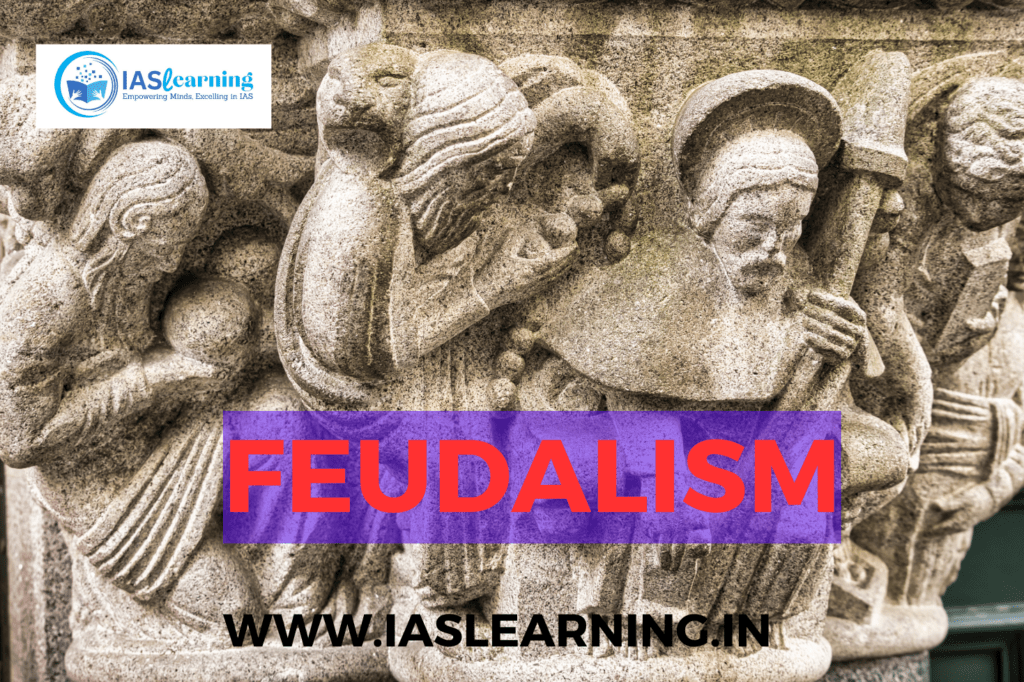Introduction to Feudalism
- Feudalism was the dominant social and economic structure in medieval Europe, roughly from the 9th to the 15th century. It emerged as a response to the need for security and stability during a time of frequent invasions and political upheaval.
- In the feudal system, the king or monarch granted land, known as fiefs, to nobles or lords in exchange for their loyalty, military service, and other forms of support. These lords, in turn, granted portions of their land to vassals, who were often knights or lesser nobles, under similar terms. This hierarchical structure created a web of reciprocal relationships and obligations, with each level of vassalage owing fealty and service to their higher-ranking lord.
- At the bottom of the feudal hierarchy were the peasants and serfs, who worked the land and provided agricultural produce in exchange for protection from their lord. The Church also played a significant role in the feudal system, with bishops and abbots often holding significant land and power.
- Feudalism was marked by the decentralization of political authority, with local lords exercising significant control over their territories. The system was further reinforced by the manorial system, where self-sufficient agricultural estates or manors were the primary economic units.
- While feudalism provided a degree of stability during turbulent times, it also resulted in a rigid social structure with limited social mobility. Over time, changes in economic and political conditions contributed to the gradual decline of feudalism and the emergence of new forms of governance and social organization in Europe.

CAUSES OF FEUDA-LISM
Feuda-lism in medieval Europe had several key causes that shaped its development:
• The collapse of Central Authority: The disintegration of the Roman Empire in the West in the 5th century CE led to the decline of centralized power. As Roman authority waned, local leaders and strongmen began to assert control over their territories, laying the foundation for feudal relationships.
• Rise of Regional Strongmen: With the vacuum created by the weakening of central authority, regional leaders, such as nobles and warlords, emerged as powerful figures in their respective domains. They offered protection and security to people in exchange for loyalty and various services, including military support.
• Influence of Tribal Structures: Feudalism was also influenced by the social and political structures of Germanic and Celtic tribes, which had a strong presence in Europe during the early medieval period. These tribal structures emphasized hierarchical relationships and the accumulation of wealth through land ownership.
• Church’s Reinforcement of Feudalism: The Catholic Church played a significant role in reinforcing the feudal system. It promoted the concept of divine right, suggesting that kings and rulers were chosen by God to govern. The Church’s own hierarchical organization, with the Pope at the top, mirrored the feudal structure, further legitimizing the system.
GEOGRAPHIC VARIATIONS OF FEUDALISM
Feuda-lism exhibited geographical variations and adaptations in different regions around the world:
• European Variations: Feudalism in Europe displayed variations from one region to another. For example, in Spain, the system was influenced by the Reconquista, a long period of Christian-Muslim conflict, which shaped the relationships between lords and vassals in the Iberian Peninsula.
• Feudal Japan: Beyond Europe, feudalism found expression in Japan, where it shared similarities with European feudalism, particularly in the context of samurai (warrior class) and lord-vassal relationships. Despite distinct cultural contexts, Japan’s feudal period featured a similar hierarchical structure.
• Indian Form of Feudalism: The Zamindari System: In India, a form of feudalism known as the Zamindari system prevailed. Under this system, landlords known as zamindars controlled extensive land holdings, while peasants worked the land as tenants. This system created a hierarchical structure with economic and power disparities akin to European feudalism.
These geographic variations illustrate how feudalism emerged and adapted in different parts of the world, often influenced by unique historical, cultural, and political contexts. Despite variations, feudal systems across regions shared common features of hierarchical relationships, land ownership, and obligations of loyalty and service.
THE GROWTH OF AGRICULTURE UNDER FEUDALISM

Agriculture played a central role in the feudal system, and the growth of agriculture was closely linked to the dynamics of feudalism:
• Role of Serfs: Serfs were essential to the agricultural aspect of feudalism. They worked the land as peasants, cultivating crops and ensuring the production of food for the entire feudal estate. Serfs provided the labor force necessary for agricultural activities, contributing to the overall agricultural growth.
IMPACT OF FEUDA-LISM
Feudalism had various impacts, both positive and negative, on medieval European society:
Positive Impacts:
• Establishment of Stable Socio-Political Hierarchy: Feudalism brought a degree of stability and order to the otherwise turbulent Middle Ages. The hierarchical structure of lords, vassals, and serfs provided a framework for social and political organization.
• Birth of the Chivalry Code: Feudalism gave rise to the chivalry code, a set of moral and behavioral standards for knights and nobles. Chivalry emphasized ideals such as honor, loyalty, bravery, and moral conduct, shaping the values of the warrior class.
• Preservation and Dissemination of Knowledge: Feudal society supported the preservation and dissemination of knowledge. Monastic schools, scriptoria (writing rooms), apprenticeships, and guilds played roles in preserving written works and passing down knowledge from one generation to the next.
• Feuda-lism and Social Cohesion: Despite its inherent flaws and inequalities, feudalism fostered a sense of community and belonging among individuals within a feudal estate. It contributed to a form of social cohesion, as people relied on each other for protection and sustenance.
Negative Impacts of Feuda-lism:
Feuda-lism also brought about negative consequences and challenges within medieval European society:
• Aggravation of Power Imbalances and Inequalities: Feudalism exacerbated existing power imbalances and deepened social and economic inequalities. Lords, particularly the nobility, amassed significant wealth and landholdings, while serfs and peasants lived in relative poverty and had limited opportunities for economic advancement.
• Hindrance to Social Mobility: Feudalism created significant barriers to social mobility. Serfs and peasants, born into their respective classes, had limited prospects for improving their social status or economic conditions within the rigid feudal class system.
• Exploitation and Oppression through Serfdom: Serfdom was a central element of feuda-lism, requiring peasants to provide labour services and pay various dues to their lords in exchange for protection and land use. This system often subjected serfs to exploitation and oppression, as they were bound to the land and the authority of their lords.
• Obstruction of Democratic Growth: The concentration of political power in the hands of a select elite, the feudal lords, hindered the development of democratic institutions. Feudal lords exercised both legislative and judicial powers within their territories, limiting opportunities for broader political participation.
Specific Examples of Feuda-lism:
• England’s Feudal System: England’s feudal system was solidified under William the Conqueror and was characterized by a combination of protective and exploitative elements. The Domesday Book, a comprehensive land survey, was conducted during this period to assess and document land ownership and taxation.
• Serfdom in Russia: Serfdom, a key component of feuda-lism, persisted in Russia for an extended period, lasting into the 19th century. This long-lasting institution demonstrated the enduring nature of feudalism in certain regions.
Legacy of Feudalism: Feudalism’s legacy extends to Europe’s subsequent political and economic developments, leaving a lasting imprint on the continent’s history. Some key aspects of its legacy include:
- Influence on Political and Economic Progressions: Feudalism played a pivotal role in shaping the political and economic progressions of Europe. It served as a precursor to the development of capitalism and the modern nation-state. The feudal system’s hierarchical structure and relationships between lords and vassals laid the groundwork for evolving political institutions and economic practices.
- Persisting Relevance in Modern Society: Elements of feuda-lism’s legacy are still relevant in modern society. Social and economic inequalities, as well as the misuse of political power to preserve the interests of the elite, continue to be pressing issues. The historical roots of these challenges can be traced back to the inequalities and power dynamics inherent in feudalism.
Form of Feuda-lism in Present Times: While not an exact comparison, some draw parallels between feudalism and modern corporate structures to illustrate power dynamics and economic inequality in contemporary society. Critics highlight similarities in how resources are controlled by a select few, akin to feudal lords, while the majority contribute their labour, akin to serfs. This comparison prompts discussions about wealth distribution and power concentration in today’s world.
Historiographical Debates: The study of feudalism has sparked historiographical debates among scholars. These debates often revolve around the definition and scope of feudalism:
- Broad vs. Localized Models: Marc Bloch advocated for a broad, pan-European model of feudalism, emphasizing common features and structures across regions. In contrast, Susan Reynolds argued that feudal institutions were too diverse and localized to constitute a single, uniform system. Her perspective highlights the variability and complexity of feudalism in different contexts.
Conclusion,
Feuda-lism left an indelible mark on medieval Europe, shaping its political, social, and economic structures. While it provided stability and defined social hierarchies, it also contributed to power imbalances and restricted social mobility. The legacy of feudalism continues to influence contemporary discussions about inequality, power dynamics, and economic structures in modern society, making it a subject of ongoing scholarly exploration and debate.
Read Related Articles




